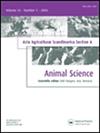瑞典家山羊及其幼山羊(Capra hircus)对15天热暴露的生理和行为反应
IF 0.9
4区 农林科学
Q3 AGRICULTURE, DAIRY & ANIMAL SCIENCE
Acta Agriculturae Scandinavica Section A-Animal Science
Pub Date : 2021-01-02
DOI:10.1080/09064702.2020.1869817
引用次数: 4
摘要
7只瑞典家山羊(Capra hircus, 2-3岁)及其幼山羊(37±4天)在室内温度高于30°C的环境中放置15天(H1-H4;无热期(C1, C2)来研究驯化。直肠温度(RT)在H1至H3期间升高1.1℃(P < 0.001,与C1相比),但在H4期间仅升高0.6℃(P < 0.001,与C1相比);P < 0.024 vs. H1)。呼吸速率(RR)在H4期的升高幅度小于H1期(P < 0.001)。热时皮肤温度升高(P < 0.001),皮肤蒸发量(SE)升高(P < 0.05)。山羊在受热期间增加水分摄入量,导致牛奶渗透压降低,而牛奶摄入量保持不变。孩子们的体温调节反应与山羊相似。因此,在热末,随着SE的增加,RT和RR的降低表明山羊已经开始适应环境。本文章由计算机程序翻译,如有差异,请以英文原文为准。
Physiological and behavioural responses of Swedish domestic goats and their kids (Capra hircus) to 15 days of heat exposure
ABSTRACT Seven Swedish domestic goats (Capra hircus, 2–3 years) and their kids (37 ± 4 days) were subjected to indoor temperatures above 30°C during 15 days (periods H1–H4; periods without heat C1, C2) to study acclimation. Rectal temperature (RT) increased by 1.1°C during H1 to H3 (P < 0.001 vs. C1), but only by 0.6°C during H4 (P < 0.001 vs. C1; P < 0.024 vs. H1). Respiration rate (RR) increased less during H4 than during H1 (P < 0.001). Skin temperature increased during heat (P < 0.001), and skin evaporation (SE), which differed from C1 to H4 (P < 0.05). Goats increased water intake during heat, resulting in lowered milk osmolality while milk offtake was maintained. Kids' thermoregulatory responses resembled those of the goats. Thus, decreasing RT and RR simultaneously with increasing SE at the end of the heat indicate that goats had started to acclimate.
求助全文
通过发布文献求助,成功后即可免费获取论文全文。
去求助
来源期刊

Acta Agriculturae Scandinavica Section A-Animal Science
农林科学-奶制品与动物科学
CiteScore
2.30
自引率
0.00%
发文量
9
审稿时长
>36 weeks
期刊介绍:
Acta Agriculturæ Scandinavica, Section A – Animal Science publishes results of original research in animal science and their applications related to the following topics:
-Animal breeding and genetics
-Molecular genetics
-Animal physiology and reproduction
-Nutrition and feeding
-Animal behaviour and welfare
-General animal husbandry and systems of production, including economic and technical aspects
-Hygiene and quality of animal products
In addition to original articles, covering basic as well as applied subjects, the journal features review articles and short communications.
Acta Agriculturæ Scandinavica, Section A – Animal Science forms part of a trilogy of titles published on behalf of the Nordic Association of Agricultural Scientists (NJF). The series also includes Section B - Soil & Plant Science and the recently launched Section C - Food Economics .
Acta Agriculturae Scandinavica A, B and C are available to purchase as a combined subscription. This provides access to all three journals in the series, and is available to institutional subscribers only. For full pricing information, please view the Taylor & Francis Journals Price List here.
Scientists in research, teaching and extension with specialised interest in animal science and production.
 求助内容:
求助内容: 应助结果提醒方式:
应助结果提醒方式:


